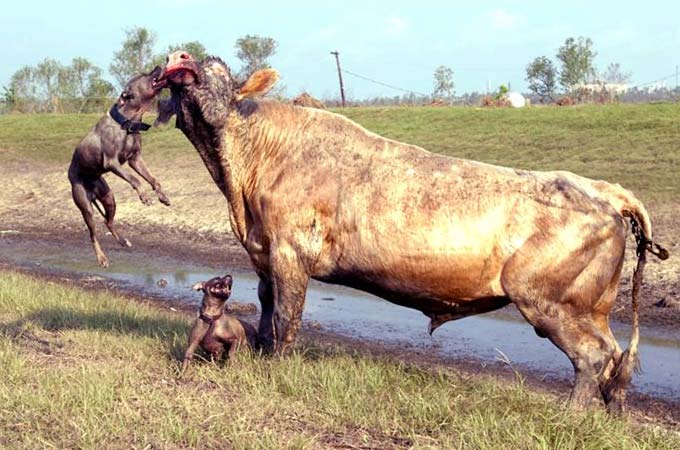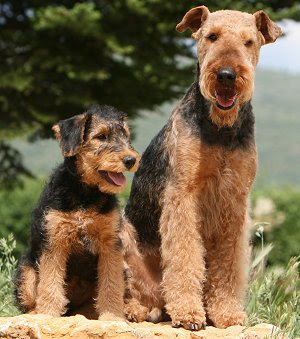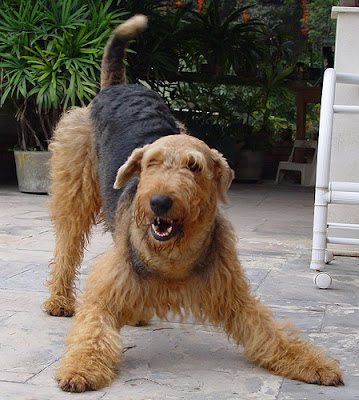An Airedale
Terrier owner for 10 years, Mary originally chose the Airedale for its temperament, loving its unique combination of a strong will with a loving heart, and its eagerness to please. She finds training her Airedales very rewarding and cautions newcomers to “Always keep your voice pleasant and never raise your voice,” a lesson she says she learned from long-time Airedale terrier breeder, Joanne Vohs. “Airedales,” Mary says, “are independent, thinking dogs that can go anywhere with their owner. They are a good match with my personality.”
Mary began working in obedience because one of her first Airedale
Terrier puppies was ”rather unruly,” and someone told her to just be patient. But she knew she had to make corrections, and Joanne Vohs helped her learn that “using a correction is giving information to your dog.” To learn how to give the corrections, she turned to obedience training, and trained with trainer Patty Biggins, known as “The Terrier Trainer” in Salt Lake City. Under Patty, Mary learned “to keep everything black and white, to keep training pleasant, and to form a mental picture in her mind of what she wants the Airedale Terrier to do. “With that picture in mind,” Mary says, “you can give corrections in such a way that you help the dog understand what you want.” Not only does she visualize her dogs working the exercises perfectly, she pictures them doing so with a good, happy attitude and their tails and ears up. This approach worked: That unruly puppy, Dave, ended up with 19 first places in obedience trials, and he finished his obedience titles through the first leg of Utility, before Mary lost him to cancer. For several years in a row, Dave held the national rank of #2 Airedale Terrier in obedience. Mary was hooked!
Since then, Mary has taken her Airedale Terriers beyond obedience, working them in agility, tracking, and now she is starting them in hunting. She says that in every discipline, regardless of how slow she may train an exercise, she always does the exercise exactly the way she wants it done. She studies how the dog works an exercise, notes the muscles that it uses, and then works the same muscles the same way time after time until the exercise is finished and smooth. To help the dog do this, she puts peanut butter or cheese on the end of a paint stick or a wooden spoon, and guides the dog the way she wants it to go. And she will patiently do one exercise that way over and over. She never moves the dog; she always makes the dog move itself and makes the dog responsible for the behavior. Once the dog knows the exercise, she fades out the lure until the Airedale Terrier performs the behavior on his own when he is asked for it. She works with her dogs so that the dogs think the work through and learn to make their own decisions.
When Mary heard about the Week of the Airedale, she was excited: For the first time, all the venues for all the dog sports that she loves would be in one place. She was excited at the prospect of really showing that Airedales can do so many things so well, and she knew that she wanted to compete with her dogs for the Most Versatile awards. She knew that if she did her training thoroughly, she could go to the Week of the Airedale and go in the rings and have fun with total confidence in her Airedale Terriers. And that is what she did. Mary understands that a Airedale Terrier can only do so much in a training session, and it takes more time to train for so many events. But Mary is already training for several venues at once. She says, “That means it takes longer to get my dogs into the show ring. I don't back down from how I want my dogs to perform. I just train all levels of the venues at once so when they are ready to show, it goes fast. I train Novice, Open and Utility all at once to keep it interesting. I train advanced agility maneuvers as soon as they know the obstacles. I train TDX and VST (variable surface tracking) skills from the beginning. This keeps it interesting, but my dogs are typically three to four years old before I feel they are mature enough to compete with the precision I want.” In other words, Mary trains them thoroughly and mixes up the events during training so that her dogs pay close attention to her and have fun; above all, she does not hurry the dogs in a rush to get into competition. Like a good teacher, she makes sure her students are ready to do what she asks them to do before putting them to the test.
To train for the Week of the Airedale Terrier, carecatdogs asked herself what she needed to do to win, and with that answer in mind, she planned out every detail: which events she would show in, how she and the dogs would prepare for those events, and what distractions her dogs would have to work with. She broke every exercise down into goals, and then identified the separate things that she needed to do with her dogs in order to reach each goal. For nearly six months, Mary and her dogs worked six nights a week. Every night, she ran through routines. Each night, she focused on one thing: heeling, head up, sits, downs, weave poles, etc. until she was satisfied that she and the dog had that part of the exercise down pat.
Because the Week of the Airedale Terrier would be held outdoors and her dogs were used to competing indoors, she moved all her training outdoors as soon as the snow was melted in Wisconsin. “That only gave me a month,” she said, but she worked her dogs outdoors every day because “It is the trainer’s responsibility to expose their dog to all the things that he will encounter in the competition.” Flapping tents, people noises, other outdoor noises, dogs barking, the wind, rain, and more: the trainer has to prepare their dogs to work with all potential distractions. This attitude paid off: after the first class, Mary noted that the grass was longer than AKC regulations permit and that the long grass threw Willy off. So after that class, she took him and practiced in the long grass until he was ignoring it. In his next class, he came in second and was one of only three out of 35 dogs to qualify.

















0 comments:
Post a Comment